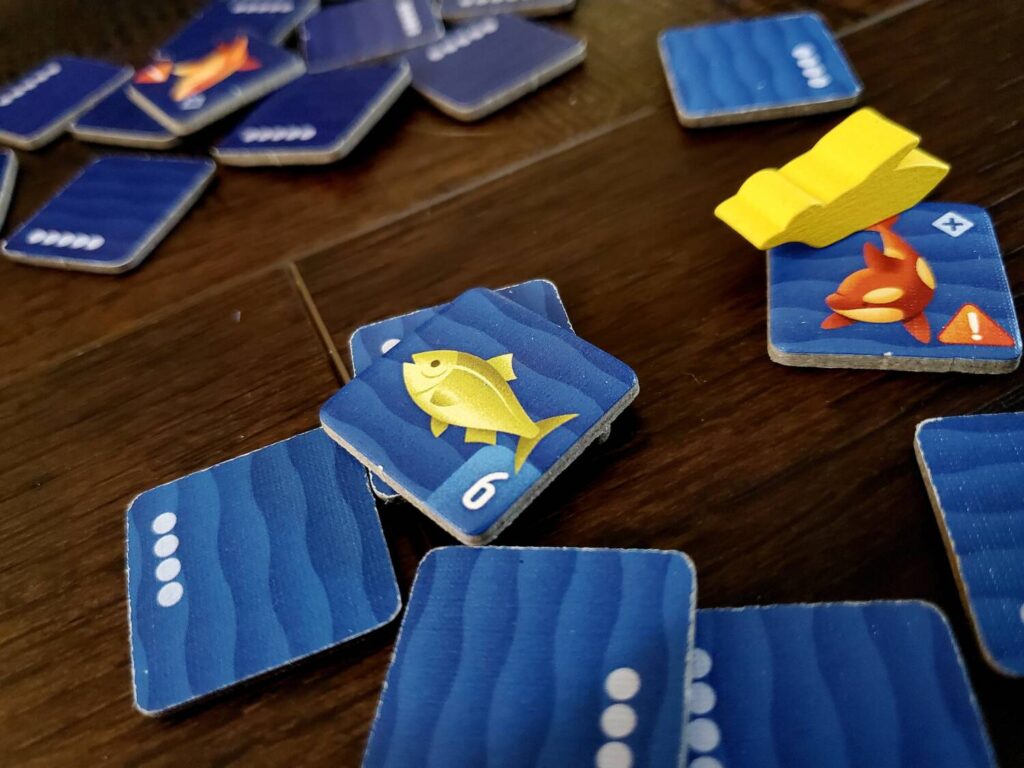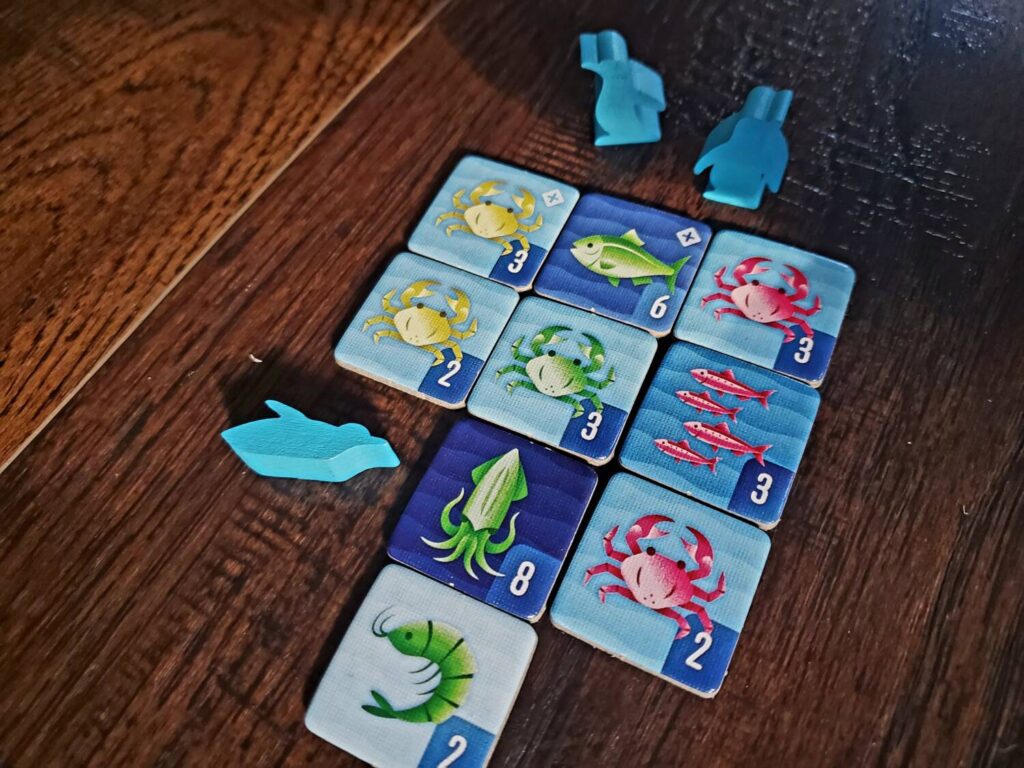The question on everyone’s mind is, of course: do penguins really eat stones? And the answer is yes. Stones lend weight and digestive help to our tuxedoed friends. It’s a good thing too, because otherwise Deep Dive would be little more than a box of lies.
Deep Dive is a cute little press-your-luck penguin game born of collaborations. The design team includes Molly Johnson, Robert Melvin, and Shawn Stankewich, whose collective work on Point Salad has been widely celebrated. The publication team includes Flatout Games and AEG (who last year took home a Spiel des Jahres award for Cascadia). For a small box, family weight game that takes less than 20 minutes to play, this thing sure brought a lot of high-caliber cooks to the kitchen!
That should land Deep Dive in the category of a sure thing.
Don’t stop me now!
The setup for Deep Dive involves flipping several dozen tiles face down, a process that will take only slightly less time than the game itself. There are five shades of blue backs representing five depths. On the flipside, the tiles bear images of food, stones, bubbles or predators.

Players slide one of their penguin meeples to the first depth and choose: either take a tile that’s already face-up or flip a new tile. Once a tile is flipped they either take that tile or they must continue to the next depth where the same choice awaits.
Food—shrimp, crab, or squid—comes in pink, yellow, or green and is the ultimate aim of the dive. Players can take any food, creating vertical columns of color-matched tiles in front of them. But in order to score full value, players must collect rows of all three colors. Otherwise each piece is only worth half. In this way, Deep Dive maintains a mathematical tension of players wanting lucrative snacks from the deep, all the while knowing they should just take the lowly shrimp in order to complete a row and unlock the full value of tiles in hand.

Stones are saved for a future round, during which the penguins eat them and dive to the depth of their choice. The stones are a brilliant design choice, promoting reckless gambling in the face of more sustainable and consistent food collection.
Bubbles force the penguins deeper.
Predators are…cuddly play partners? When a predator is revealed, the penguin stays on that tile for a time, not to be eaten but to serve as a distraction. In future turns, if a penguin is playing with a predator buddy at a given depth, the new penguin simply passes by to the next depth unnoticed. Would you play with a shark to help a friend? No? Maybe you weren’t cut out for the penguin life. When all three penguin meeples are thoroughly distracted in this way, the player recollects them along with one visible food from one of the levels where they were detained. No penguins die in these waters.
And so it goes. Players keep diving and collecting until one of the depths is entirely flipped face-up, at which point sets are finalized and scores calculated to determine a winner.
Squeals of delight
Deep Dive is a breezy family delight. The first play with the younger kids was a mishmash of squeals and chanting. Once my daughter realized that the stones could give her a shot at the deepest waters (and that the sharks weren’t going to eat her new friends), she was on the hunt. Sure, she was grabbing food along the way, but she wanted the best food and she gave off every sound effect, giggle, and scream that she could muster in her pursuit. She had the time of her life.

We played as a table of adults. The pitch and decibel level were a tad lower, but everyone was pretty thrilled with the game. It sets up quickly and it plays quickly. Turns end in a flash and the aims are crystal clear from the beginning. There’s almost nothing serious about it, and that’s the genius.
The “unlimited column but row-dependent” scoring is reminiscent of World’s Fair 1893, which is another favorite in our household. This brand of set collection sets purely opportunistic play (gobbling high values with reckless abandon) up against measured calculation (needing diversity to realize potential). The resulting tension is always interesting.

Letting the penguins play with their enemies is also pretty brilliant from a design standpoint. No one wants to stare down an orca, but it’s nice to know the little fella will come home eventually. Such distractions are nowhere near the top of the list of penguins’ natural defenses (such as speeding away), but I like to think noble sacrifice is in there somewhere. And once they get away, it makes sense they’d grab a bit for the road on the way back.
What I love about a game like Deep Dive is the ease of entry. With six possible players, it’s easy to get it to the table and have a good time. It’s fast enough that the first game can serve as a teaching game before getting “serious” in the second. It has a few thrilling moments up its sleeve and it delivers consistently across the board.
By the book, the setup involves digging through the tiles to remove specific numbers of specific types for the sake of balance, but after the first game we totally disregarded the tedium. We peek at the table in the rulebook, add up the total number of removed tiles and just pull them out at random. This might mean a few missing stones or a disproportionate number of predators, but it’s a fluffy press-your-luck game. Inconsistency only feeds the ethos.
Get in the water
It’s easy to spill a few too many words when a game is just pure fun. Deep Dive is a winner. Pure and simple, the sort of game you can laugh over and enjoy the light tension. And for less than $20, it’s worth every penny.












Add Comment